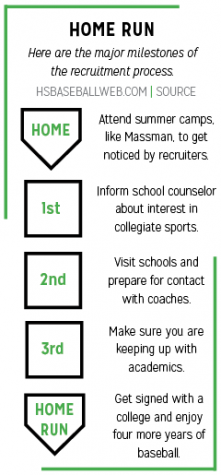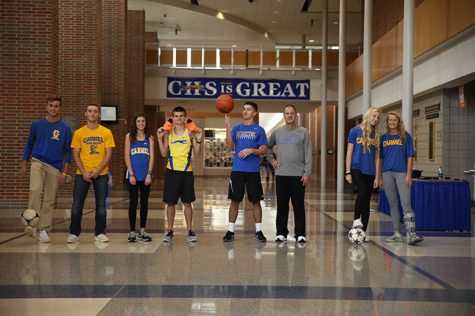Parker Massman, baseball player and senior, participated in a college camp where there were about fifty colleges at the camp, ranging from Division 1 to Division 3. This college camp allowed him to begin his recruiting process. After the camp, Massman began receiving calls from colleges. He was a freshman at the time. 
“I didn’t even really know what I wanted in a college at that point, so I had to do a lot of research. At the same time, it was a cool feeling knowing that college coaches were interested at such an early stage,” Massman said.
Despite the “cool feeling” of young recruitment, much can change before a student-athlete reaches college. Athletes aren’t allowed to sign their National Letter of Intent (NLI) until their senior year, but many commit long before they sign.
“You’re seeing a lot more commitments from kids at a really, really young age, before they really know what they want to do, major-wise, or what is the best fit for a school,” Athletics Director Jim Inskeep said.
Massman said many baseball players commit even before their freshman year of high school.
“A lot of people in eighth grade aren’t even mature yet, like their bodies aren’t mature. You don’t even know what you really want in a school, and you haven’t even really thought about it as an eighth grader. I mean, I was still having trouble as a junior in high school, so I definitely think that colleges are recruiting too early,” Massman said.
According to the National Collegiate Athletic Association (NCAA), 480 thousand athletes participated in a college sport in the 2014-15 school year, 34 thousand of whom were baseball players like Massman. However, that number plummeted from high school to college. In high school, there were 486 thousand students who played baseball, meaning only 7 percent of these high school athletes played in college. Other sports show a similar trend, making the recruiting process even more stressful for students.
“(The recruiting process was) very emotionally draining on family, athlete and coaches,” Katie Bailey, college gymnast and freshman at Lindenwood University, said via email.
Bailey started emailing colleges freshman year of high school but didn’t commit until the beginning of her senior year.
Bailey, Massman and Inskeep all said colleges recruit too early, and certain schools have responded to these complaints. For example, on Sept. 21, the Ivy League proposed new legislation preventing colleges from offering financial aid or admission support before the athlete’s junior year. Coaches also cannot communicate with the student-athlete, whether by phone, unofficial visits or in person during camps or clinics.
Massman said, “There’s gonna be a lot of ups and downs and stuff, but just remember that in the end, if someone wants you, you’re gonna play somewhere.”































![British royalty are American celebrities [opinion]](https://hilite.org/wp-content/uploads/2024/03/Screenshot-2024-03-24-1.44.57-PM.png)




















![Review: Quiet on Set: The Dark Side of Kids TV is the long awaited exposé of pedophilia within the children’s entertainment industry [MUSE]](https://hilite.org/wp-content/uploads/2024/04/unnamed.jpg)
![Review: “The Iron Claw” cannot get enough praise [MUSE]](https://hilite.org/wp-content/uploads/2024/04/unnamed.png)
![Review: “The Bear” sets an unbelievably high bar for future comedy shows [MUSE]](https://hilite.org/wp-content/uploads/2024/03/unnamed.png)
![Review: “Mysterious Lotus Casebook” is an amazing historical Chinese drama [MUSE]](https://hilite.org/wp-content/uploads/2024/03/0.webp)
![Thea Bendaly on her Instagram-run crochet shop [Biz Buzz]](https://hilite.org/wp-content/uploads/2024/03/IMG_0165-1200x838.jpg)
![Review in Print: Maripaz Villar brings a delightfully unique style to the world of WEBTOON [MUSE]](https://hilite.org/wp-content/uploads/2023/12/maripazcover-1200x960.jpg)
![Review: “The Sword of Kaigen” is a masterpiece [MUSE]](https://hilite.org/wp-content/uploads/2023/11/Screenshot-2023-11-26-201051.png)
![Review: Gateron Oil Kings, great linear switches, okay price [MUSE]](https://hilite.org/wp-content/uploads/2023/11/Screenshot-2023-11-26-200553.png)
![Review: “A Haunting in Venice” is a significant improvement from other Agatha Christie adaptations [MUSE]](https://hilite.org/wp-content/uploads/2023/11/e7ee2938a6d422669771bce6d8088521.jpg)
![Review: A Thanksgiving story from elementary school, still just as interesting [MUSE]](https://hilite.org/wp-content/uploads/2023/11/Screenshot-2023-11-26-195514-987x1200.png)
![Review: When I Fly Towards You, cute, uplifting youth drama [MUSE]](https://hilite.org/wp-content/uploads/2023/09/When-I-Fly-Towards-You-Chinese-drama.png)
![Postcards from Muse: Hawaii Travel Diary [MUSE]](https://hilite.org/wp-content/uploads/2023/09/My-project-1-1200x1200.jpg)
![Review: Ladybug & Cat Noir: The Movie, departure from original show [MUSE]](https://hilite.org/wp-content/uploads/2023/09/Ladybug__Cat_Noir_-_The_Movie_poster.jpg)
![Review in Print: Hidden Love is the cute, uplifting drama everyone needs [MUSE]](https://hilite.org/wp-content/uploads/2023/09/hiddenlovecover-e1693597208225-1030x1200.png)
![Review in Print: Heartstopper is the heartwarming queer romance we all need [MUSE]](https://hilite.org/wp-content/uploads/2023/08/museheartstoppercover-1200x654.png)























![Review: Ladybug & Cat Noir: The Movie, departure from original show [MUSE]](https://hilite.org/wp-content/uploads/2023/09/Ladybug__Cat_Noir_-_The_Movie_poster-221x300.jpg)

![Review: Next in Fashion season two survives changes, becomes a valuable pop culture artifact [MUSE]](https://hilite.org/wp-content/uploads/2023/03/Screen-Shot-2023-03-09-at-11.05.05-AM-300x214.png)
![Review: Is The Stormlight Archive worth it? [MUSE]](https://hilite.org/wp-content/uploads/2023/10/unnamed-1-184x300.png)


